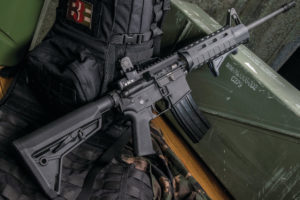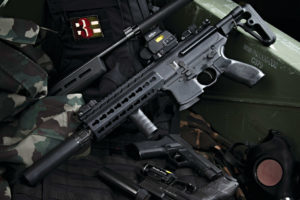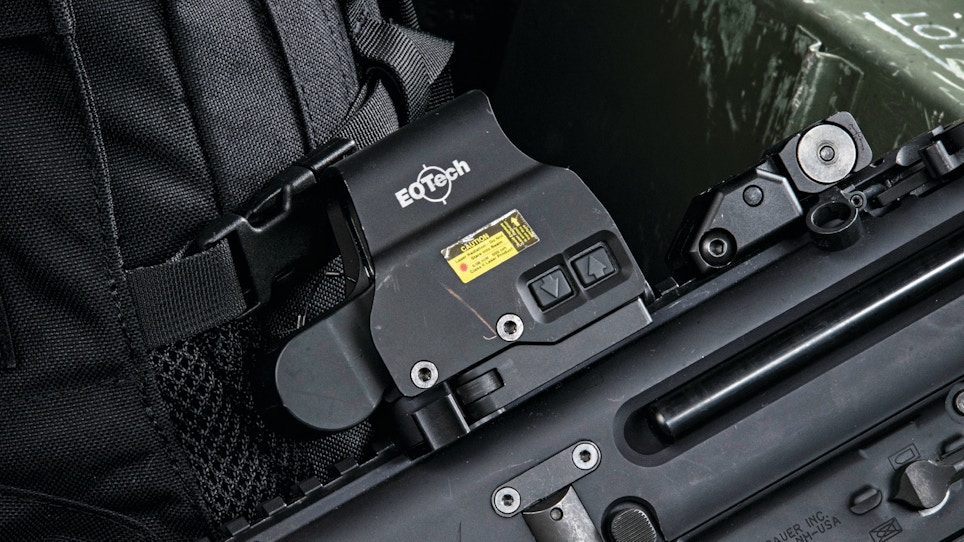This EOTech XPS unit is expensive. Selling it separately from a traded-in gun can mean much bigger profits. (Photo: Jim Grant)
Unlike automobiles and consumer electronics such as laptops and smart phones, firearms don’t depreciate by very much. That makes reselling used guns at a retail location fairly easy, and normally, pretty lucrative.
That is good news for smaller shops that buy and sell guns. Used guns (if not neglected or banged up) can be purchased for relatively cheap, cleaned up and resold for a tidy profit. Smart business owners will often buy up used hunting shotguns and rifles right after hunting season concludes, then wait to sell them until the next season when demand increases.
But this isn’t really possible with one particular type of firearm — the tactical gun — which to be frank, isn’t really a type of firearm so much as a categorization of any firearm with a “tactical” appearance. Don’t misunderstand me, several folks enjoy hunting with firearms previously considered unsuitable hunting. The AR-10 platform for instance looks like an over-sized AR-15 chambered in .308, but this larger-bore, direct impingement rifle is incredibly accurate and has enough stopping power to ethically hunt large game.
While I personally hunt whitetail deer with an AR-10, most hunters do not. That brings up an interesting concern. With no discernable “season” for these types of guns, retailers have to either wait for election cycles or modify their sales model to maximize profit with these types of firearms.
This article couldn’t be more pertinent today with Donald Trump as president. Ever since Barack Obama took office, the price and production of firearms and ammunition have gone through the roof. No type of firearm saw greater sales than tactical firearms such as AR-15s and semi-automatic pistols such as the Glock series of handguns.
Obviously, these sales were driven by fears of a new Assault Weapons Ban like the 1994 ban that expired under President George W. Bush’s presidency. Now, after one of the largest proponents of the ban lost the presidential election, many buyers who overstretched their budgets looking for quick profits from panic buyers are stuck with these guns.
This is potentially great news for resellers and bad news for manufacturers. While it may be tempting to buy up every single AR or handgun priced well below MSRP for resale, it’s important to understand a few crucial points.
For instance, resellers now have their pick of the litter, so buying questionable quality AR-15 lowers doesn’t make since unless they can do so for pennies on the dollar. A better investment is in mid-level products with established names and quality. They won’t make you as much profit as an affordably-priced, high-end product like a Noveske rifle, but they’ll be much easier to resell in your local market.
That said, if your shop sells online, buy any high-end gun offered at a great price. Finding a buyer for a cheap Colt, SIG or Daniel Defense carbine is very easy with millions of potential online costumers. If your shop is smaller and only deals with local buyers, make sure you don’t stock up on guns your customers can’t afford.

Certain brands of AR-15 command higher prices than others like this Bravo Company Machine C8 clone with Magpul MOE Slim Line furniture.
Consider this example
Here’s one great example. A local shop near me purchased an unfired Barrett M82 .50-caliber rifle from an estate sale for just a little over half of MSRP. Despite being a fantastic deal, they tried in vain to sell this gun locally for more than three years.
When the owner’s son decided to set up an online Gunbroker.com account to sell some of their guns online, the Barret was sold less than 48 hours. Sure, they ended up making a good profit on that rifle, but three years is a long time to hang on to a product.
Which brings me to one of the biggest areas of frustration and misconception in the used gun world — accessories.
Back when I was a young man in college, I rarely had enough money to buy the guns, ammo and accessories I wanted. This began a series of horse-trading deals that gave me some insight into the minds of tactical firearm sellers.
In nearly every deal I saw, sellers over-valued accessories and buyers undervalued them. The guy with a beat up WASR AKM carbine may have dropped $300 extra on his Chinese-made M4 stock adaptor, railed dustcover and knock-off ACOG, but these are virtually worthless in a used market.
Which isn’t to say anything non-OEM or non-stock holds no value. Name-brand accessories such as Aimpoint, Trijicon or Surefire are well-known enough for prospective clients to appreciate. That said, it often makes more sense to sell those items piecemeal rather than as a bundle. This is doubly true for online resellers.
For brick and mortar guys, these items can be used as bargaining chips when selling or trading used guns. For example, a guy wants to sell a nice SIG MCX carbine to a shop, but won’t take anything less than $1,000 for it.
The gun retails for about $1,800, but street prices are normally closer to $1,500. After taxes, you might make $300 off this gun if you find a buyer. But say you bought another gun earlier with a Trijicon ACOG on it. What happens then?
If you only have something like $300 invested in that ACOG, you could offer the ACOG to the guy plus $400 cash, and in his mind, he made out like a bandit. Meanwhile, you can turn a bigger profit on that MCX now that you only have $700 invested in it. Plus, everyone involved leaves happy and content they got a good deal.
Also, while I normally suggest shops stay away from “tacticool” furniture on guns (especially AK rifles), I make an exception for quality products like MOE furniture from Magpul and carbon fiber handguards from Lancer industries.
When pricing out a gun to buy from a seller, anything ultra-niche like Zenit stocks and handguards for the AK or knock-offs should be ignored. The seller will tell you how awesome his sniper AK is, but the $50 Chinese scope or the ultra-rare aluminum pistol grip from Zenit will be difficult for the average shop to get a return on.

When buyers don’t feel that urgency to buy whatever they can get their hands on, they expect a functional, out-of-the-box-ready rifle.
Is it ready to use now?
One rule of thumb I use when recommending what to keep on a gun and what to sell off is to ask a simple question: is the gun ready to use as it comes?
Hunters are used to buying rifles without optics or iron sights, tactical Joes aren’t. So, if you’re selling an AR-15 that came with irons, include them in the used gun or adjust the price accordingly. Doing so ensures the consumer is happy with the purchase. No one likes feeling nickeled-and-dimed when they’re spending hundreds of dollars on a gun.
This is something the market will have to adapt for now that panic-buying will decline or end for at least a few years. When buyers don’t feel that urgency to buy whatever they can get their hands on, they expect a functional, out-of-the-box-ready rifle.
So, while it’s a great idea to sell high-end accessories like optics separately, it might be wise for resellers to invest in a few sets of inexpensive back up iron sights like Magpul Dynamic’s polymer BUIS. These are fairly cheap, but make the gun seem more complete.
AK rifles on the other hand don’t have this issue; they all ship with the same set of post and notch iron sights. The only thing a seller needs to worry about are scope mounts for Kalashnikovs. Word of advice: railed dust covers are worthless. They don’t hold zero and often fly off the gun after a few magazines. The only exceptions are those that also attach somewhere else on the rifle, like the rear sight assembly or to the handguards.
But what about handguns? These don’t normally have many accessories included when bought or sold.
For used tactical pistols, the seller should always try to include any accessories that originally shipped with the pistol if possible. If a shop is buying a handgun from a seller for their shop, magazines and name-brand tactical lights are the only accessories they should pay for.
When reselling any pistol, magazines can be used to increase perceived value. If a consumer seems on the fence about buying that used Glock 19, offer an extra magazine or two without dropping the price to assuage their fears.
Also, if the pistol in question is rare like a Desert Eagle or an FN FiveseveN, offering extra magazines for the pistol at half their normal price is a great way to get the buyer to clear your shop of products that might otherwise never be purchased.
As far as other accessories such as tactical lights or holsters, those can normally be cleaned up and resold for good money whether your shop is online or not. Again, buying niche is a risky investment on holsters and handguns. If the price is too good to pass up, take a chance at it, otherwise pass on the gun unless you personally want to own one.
Selling tactical firearms isn’t rocket science, but it does require a different frame of mind than selling more traditionally styled guns. The modular aspects of the AR-15’s design that makes it so popular, also makes selling the guns tricky. Deciding what to include and what to sell off can be maddening.






